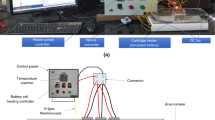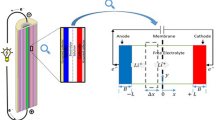Abstract
In this article, effect of spacing between the battery cells (\(\bar{W}_{\text{f}}\)) on thermal performance of Li-ion battery cells is investigated in detail. Developing a finite volume method-based numerical code for the present analysis, conjugate boundary condition at the cell and coolant interface is considered. SIMPLE algorithm employed for solving the Navier–Stokes equation is validated with famous benchmark lid-driven cavity problem. The heat generation inside the modern battery cell is uniform in accordance with cell zone. Air being the coolant flows between the channel spacing of the battery cells. Forced laminar flow of coolant and steady-state analysis with operating parameters like heat generation term (\(\bar{S}_{\text{q}}\)), Reynolds number (Re), conduction–convection parameter (ζcc), and aspect ratio (Ar) is analyzed with main focus of \(\bar{W}_{\text{f}}\). The range of \(\bar{W}_{\text{f}}\) is from 0.02 to 0.14 varied in steps of 0.02 and Re from 250 to 2000 in step of 250. Coupled heat transfer behavior in terms of maximum temperature and average Nusselt number for these parameters is provided. From the numerical analysis, it is observed that for most of the range of operating parameters, at \(\bar{W}_{\text{f}} = 0.02\), causes a sudden increase in temperature distribution and rise in maximum temperature above critical limits. Average Nusselt number increased with decrease in \(\bar{W}_{\text{f}}\) up to 0.04 and below this, it dropped. Spacing of \(\bar{W}_{\text{f}} = 0.04\) and \(\bar{W}_{\text{f}} = 0.06\) proved to be an optimal spacing at which average Nusselt number is the highest and the maximum temperature is within the safe limit for parameters considered.

















Similar content being viewed by others
Abbreviations
- Ar :
-
Aspect ratio of battery cell
- C f,x :
-
Dimensionless friction coefficient
- L :
-
Length of battery cell
- k :
-
Thermal conductivity
- l o :
-
Length of extra outlet fluid domain
- l i :
-
Length of extra fluid domain
- h :
-
Convective heat transfer coefficient
- L o :
-
Dimensionless length of extra outlet fluid domain
- L i :
-
Dimensionless length of extra inlet fluid domain
- Nu :
-
Nusselt number
- q′′′ :
-
Volumetric heat generation
- \(\bar{q}\) :
-
Non-dimensional heat flux
- \(\bar{S}_{\text{q}}\) :
-
Dimensionless volumetric heat generation
- Pr :
-
Prandtl number
- Re :
-
Reynolds number
- T :
-
Temperature
- T o :
-
Maximum allowable temperature of battery cell
- \(\bar{T}\) :
-
Non-dimensional temperature
- u :
-
Velocity along the axial direction
- U :
-
Non-dimensional velocity along the axial direction
- u ∞ :
-
Free stream velocity
- v :
-
Velocity along the transverse direction
- Q r :
-
Heat removed from the surface (non-dimensional)
- V :
-
Non-dimensional velocity along the transverse direction
- w :
-
Half width
- \(\bar{W}\) :
-
Non-dimensional width
- x :
-
Axial direction
- X :
-
Non-dimensional axial direction
- y :
-
Transverse direction
- Y :
-
Non-dimensional transverse direction
- α :
-
Thermal diffusivity of fluid
- ν :
-
Kinematic viscosity of fluid
- ρ :
-
Density of fluid
- ζ cc :
-
Conduction–convection parameter
- μ :
-
Dynamic viscosity
- c:
-
Center
- f:
-
Fluid domain
- avg:
-
Average
- s:
-
Solid domain (battery cell)
- surf:
-
Surface
- ∞:
-
Free stream
- m:
-
Mean
References
Huang P, Verma A, Robles DJ, Wang Q, Mukherjee P, Sun J. Probing the cooling effectiveness of phase change materials on lithium-ion battery thermal response under overcharge condition. Appl Therm Eng. 2018;132:521–30. https://doi.org/10.1016/j.applthermaleng.2017.12.121.
Feng X, Ouyang M, Liu X, Lu L, Xia Y, He X. Thermal runaway mechanism of lithium ion battery for electric vehicles: a review. Energy Storage Mater. 2018;10:246–67. https://doi.org/10.1016/j.ensm.2017.05.013.
Omar N, Monem M, Firouz Y, Salminen J, Smekens J. Lithium iron phosphate based battery–assessment of the aging parameters and development of cycle life model. Appl Energy. 2014;113:1575–85.
Panchal S, Dincer I, Agelin-Chaab M, Fraser R, Fowler M. Experimental and theoretical investigations of heat generation rates for a water cooled LiFePO4 battery. Int J Heat Mass Transf. 2016;101:1093–102.
Situ W, Zhang G, Li X, Yang X, Wei C, Rao M, et al. A thermal management system for rectangular LiFePO4 battery module using novel double copper mesh-enhanced phase change material plates. Energy. 2017;141:613–23. https://doi.org/10.1016/j.energy.2017.09.083.
Richter F, Kjelstrup S, Vie PJS, Burheim OS. Thermal conductivity and internal temperature profiles of Li-ion secondary batteries. J Power Sources. 2017;359:592–600. https://doi.org/10.1016/j.jpowsour.2017.05.045.
Pesaran AA. Battery thermal models for hybrid vehicle simulations. J Power Sources. 2002;110:377–82.
Chen S, Wan C, Wang YY. Thermal analysis of lithium-ion batteries. J Power Sources. 2005;140:111–24.
Hatchard T, MacNeil D, Basu A. Thermal model of cylindrical and prismatic lithium-ion cells. J Electrochem Soc. 2001;148:A755–61.
Kim G, Pesaran A, Spotnitz R. A three-dimensional thermal abuse model for lithium-ion cells. J Power Sources. 2007;170:476–89.
Guo G, Long B, Cheng B, Zhou S, Xu P, Cao B. Three-dimensional thermal finite element modeling of lithium-ion battery in thermal abuse application. J Power Sources. 2010;195:2393–8.
Smith K, Wang CY. Power and thermal characterization of a lithium-ion battery pack for hybrid-electric vehicles. J Power Sources. 2006;160:662–73.
Sun H, Wang X, Tossan B, Dixon R. Three-dimensional thermal modeling of a lithium-ion battery pack. J Power Sources. 2012;206:349–56.
Doh C, Kim D, Kim H, Shin H, Jeong YD. Thermal and electrochemical behaviour of C/LixCoO2 cell during safety test. J Power Sources. 2008;175:881–5.
Chiu K, Lin C, Yeh S, Lin Y, Chen KC. An electrochemical modeling of lithium-ion battery nail penetration. J Power Sources. 2014;251:254–63.
Liu Z, Wang Y, Zhang J, Liu Z. Shortcut computation for the thermal management of a large air-cooled battery pack. Appl Therm Eng. 2014;66:445–52.
Pesaran A, Keyser M, Burch S. An approach for designing thermal management systems for electric and hybrid vehicle battery packs. In: Fourth Vehicle Thermal Management Systems Conference and Exhibition, London, UK;1999.
Xu X, He R. Review on the heat dissipation performance of battery pack with different structures and operation conditions. Renew Sustain Energy Rev. 2014;29:301–15.
Fan L, Khodadadi J, Pesaran AA. A parametric study on thermal management of an air-cooled lithium-ion battery module for plug-in hybrid electric vehicles. J Power Sources. 2013;238:301–12.
Wang T, Tseng K, Zhao J, Wei Z. Thermal investigation of lithium-ion battery module with different cell arrangement structures and forced air-cooling strategies. Appl Energy. 2014;134:229–38.
Wu M, Liu K, Wang Y, Wan CC. Heat dissipation design for lithium-ion batteries. J Power Sources. 2002;109:160–6.
Chalise D, Shah K, Prasher R, Jain A. Conjugate heat transfer analysis of air/liquid cooling of a Li-ion battery pack. J Electrochem Energy Convers Storage. 2017. https://doi.org/10.1115/1.4038258.
Zolot M, Pesaran A, Mihalic M. Thermal evaluation of Toyota Prius battery pack. SAE Tech Pap 2002: No. 2002-01-1962.
Zolot M, Kelly K, Keyser M, M Mihalic. Thermal evaluation of the Honda insight battery pack. In: Intersociety Energy Conversion Engineering Conference, SAE; 1999: 2001, p. 923–8.
Choi Y, Kang DM. Prediction of thermal behaviors of an air-cooled lithium-ion battery system for hybrid electric vehicles. J Power Sources. 2014;270:273–80.
Wang T, Tseng K, Zhao J. Development of efficient air-cooling strategies for lithium-ion battery module based on empirical heat source model. Appl Therm Eng. 2015;90:521–9.
Yang N, Zhang X, Li G, Hua D. Assessment of the forced air-cooling performance for cylindrical lithium-ion battery packs: a comparative analysis between aligned and staggered cell. Appl Therm Eng. 2015;80:55–65.
Xu X, He R. Research on the heat dissipation performance of battery pack based on forced air cooling. J Power Sources. 2013;240:33–41.
Zhao J, Rao Z, Huo Y, Liu X, Li Y. Thermal management of cylindrical power battery module for extending the life of new energy electric vehicles. Appl Therm Eng. 2015;85:33–43.
Mohammadian S, Rassoulinejad-Mousavi SM. Thermal management improvement of an air-cooled high-power lithium-ion battery by embedding metal foam. J Power Sources. 2015;296:305–13.
Dincer I, Hamut H, Javani N. Thermal management of electric vehicle battery systems. New York: Wiley; 2017. https://doi.org/10.1002/9781118900239.
Richter F, Vie PJS, Kjelstrup S, Burheim OS. Measurements of ageing and thermal conductivity in a secondary NMC-hard carbon Li-ion battery and the impact on internal temperature profiles. Electrochim Acta. 2017;250:228–37. https://doi.org/10.1016/j.electacta.2017.07.173.
Panchal S, Dincer I, Agelin-Chaab M, Fraser R, Fowler M. Thermal modeling and validation of temperature distributions in a prismatic lithium-ion battery at different discharge rates and varying boundary conditions. Appl Therm Eng. 2016;96:190–9. https://doi.org/10.1016/j.applthermaleng.2015.11.019.
Karimi G, Li X. Experimental investigation of an adsorptive thermal energy storage. Int J Energy Res. 2012;37:13–24. https://doi.org/10.1002/er.1956.
Xu XM, He R. Research on the heat dissipation performance of battery pack based on forced air cooling. J Power Sources. 2013;240:33–41. https://doi.org/10.1016/j.jpowsour.2013.03.004.
Maleki H, Al Hallaj S, Selman JR, Ralph B, Dinwiddie B, Wang H. Thermal properties of Lithium-Ion battery and components. J Electrochem Soc. 1999;146:947–54. https://doi.org/10.1149/1.1391704.
Werner D, Loges A, Becker DJ, Wetzel T. Thermal conductivity of Li-ion batteries and their electrode configurations—a novel combination of modelling and experimental approach. J Power Sources. 2017;364:72–83. https://doi.org/10.1016/j.jpowsour.2017.07.105.
Yu K, Yang X, Cheng Y, Li C. Thermal analysis and two-directional air flow thermal management for lithium-ion battery pack. J Power Sources. 2014;270:193–200. https://doi.org/10.1016/j.jpowsour.2014.07.086.
Ghia U, Ghia KN, Shin CT. High-Re solutions for incompressible flow using the Navier–Stokes equations and a multigrid method. J Comput Phys. 1982;48:387–411. https://doi.org/10.1016/0021-9991(82)90058-4.
Jahangeer S, Ramis MK, Jilani G. Conjugate heat transfer analysis of a heat generating vertical plate. Int J Heat Mass Transf. 2007;50:85–93. https://doi.org/10.1016/j.ijheatmasstransfer.2006.06.042.
Ramis MK, Jilani G, Jahangeer S. Conjugate conduction-forced convection heat transfer analysis of a rectangular nuclear fuel element with non-uniform volumetric energy generation. Int J Heat Mass Transf. 2008;51:517–25. https://doi.org/10.1016/j.ijheatmasstransfer.2007.05.019.
Park H. A design of air flow configuration for cooling lithium ion battery in hybrid electric vehicles. J Power Sources. 2013;239:30–6. https://doi.org/10.1016/j.jpowsour.2013.03.102.
Sato N. Thermal behavior analysis of lithium-ion batteries for electric and hybrid vehicles. J Power Sources. 2001;99:70–7. https://doi.org/10.1016/S0378-7753(01)00478-5.
Mahamud R, Park C. Reciprocating air flow for Li-ion battery thermal management to improve temperature uniformity. J Power Sources. 2011;196:5685–96. https://doi.org/10.1016/j.jpowsour.2011.02.076.
Tong W, Somasundaram K, Birgersson E, Mujumdar AS, Yap C. Thermo-electrochemical model for forced convection air cooling of a lithium-ion battery module. Appl Therm Eng. 2016;99:672–82. https://doi.org/10.1016/j.applthermaleng.2016.01.050.
Author information
Authors and Affiliations
Corresponding author
Rights and permissions
About this article
Cite this article
Afzal, A., Mohammed Samee, A.D., Abdul Razak, R.K. et al. Effect of spacing on thermal performance characteristics of Li-ion battery cells. J Therm Anal Calorim 135, 1797–1811 (2019). https://doi.org/10.1007/s10973-018-7664-2
Received:
Accepted:
Published:
Issue Date:
DOI: https://doi.org/10.1007/s10973-018-7664-2




